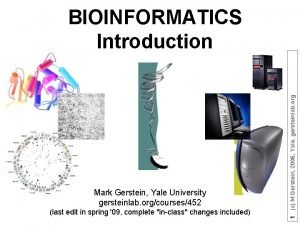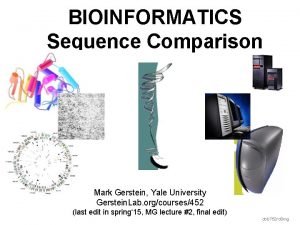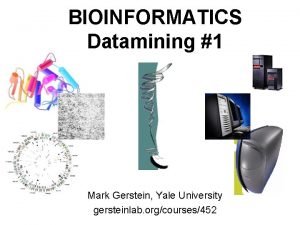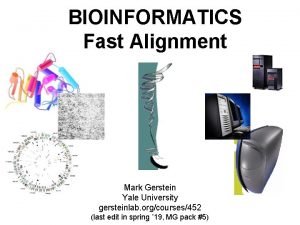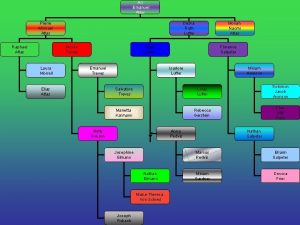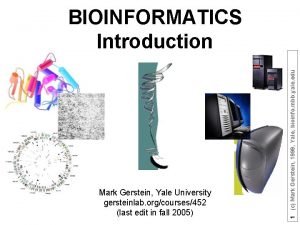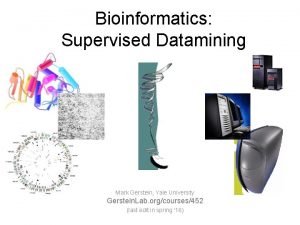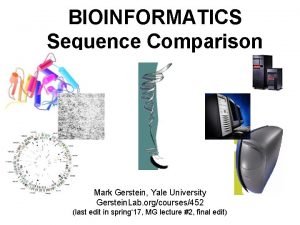Challenge 4 Yale CMG 1 Mark Gerstein Lectures


![[Nature 547: 40] 3 • ENCODE has developed non-coding annotations & a number of [Nature 547: 40] 3 • ENCODE has developed non-coding annotations & a number of](https://slidetodoc.com/presentation_image_h2/e019a21203cb763c7594a3f87ddf9277/image-3.jpg)


- Slides: 5

Challenge 4 – Yale CMG 1 Mark Gerstein - Lectures. Gerstein. Lab. org Moving beyond coding regions

Moving beyond coding • CMG projects have been mostly WES, with a few incorporating WGS (incl. Dubowitz & unsolved cases). 2 - Lectures. Gerstein. Lab. org • Compared to WES, interpreting variants in non-coding regions is challenging. 3 things to consider in this regard (annotation qual. , differential impact, variant qual. ) …
![Nature 547 40 3 ENCODE has developed noncoding annotations a number of [Nature 547: 40] 3 • ENCODE has developed non-coding annotations & a number of](https://slidetodoc.com/presentation_image_h2/e019a21203cb763c7594a3f87ddf9277/image-3.jpg)
[Nature 547: 40] 3 • ENCODE has developed non-coding annotations & a number of tools have been developed to synthesize these (eg Haplo. Reg, Fun. Seq, &c) • Compared to coding regions, the underlying functional territory of non-coding regions is not as well defined nor is the differential effect of different mutations • This creates power issues in non-coding variant prioritization. More precise (ie more compact) annotation may be useful. • Also, integration of tissue-specific annotations & epigenetic data is important for deciphering impact of non-coding variants - Lectures. Gerstein. Lab. org Things to consider in moving beyond coding #1: Quality & scale of coding v. non-coding annotation & the impact of this on statistical power

Things we need to consider in moving from coding to non-coding #2: Most of the high-impact variants found so far tend to occur in coding regions (lessons from cancer genomics) high Common variants found in GWAS Drivers found from cohort-level recurrence Mendelian risk variants found from family studies • Somatic coding driver vs noncoding passenger as an example of extreme dichotomy. Or is this a function of ascertainment ? Effect Size • Despite 1000 s of WGS call sets, very few non-coding drivers have been found in cancer genomics low [Adapted from Thomas et al. , Lancet ('15)] Passenger mutations VUS in Mendelian studies • In general (ie for CMG), do highimpact variants tend to occur in coding regions & “softer” regulatory ones, in non-coding regions? 4 Common SNPs w/o clinical utility - Lectures. Gerstein. Lab. org [Rhienbay et al bio. Rxiv ’ 17; Khurana et al NRG ’ 16]

Things we need to consider in moving from coding to non-coding #3: Variant calls (even coding ones) from WGS maybe more informative & accurate • WGS can detect full spectrum of variants including SNPs, INDELs, & SVs, in particular, are harder to interpret just in terms of exomes [Yang et al. AJHG ‘ 15]. • Accuracy of mapping can be better (even to coding), esp. w/ regard to repeats & pseudogenes [Zhang et al. PLOS Comp. Bio. [Belkadi et al. PNAS. ’ 15]. • WGS also makes possible more precise references for mapping – ie individualspecific, personal dipoloid genomes & population specific references [Chaisson et al. NRG ’ 15; Rozowsky et al. MSB ‘ 11]. 5 • Potentially better uniformity in coverage may lead to better accuracy in coding variants (& handling of mosaicism) - Lectures. Gerstein. Lab. org ‘ 17].
